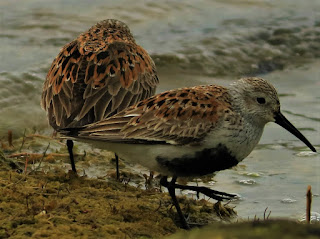The song of a Varied Thrush isn't so much a song as it is an audible sketching of the mysterious and brooding beauty of this wilderness coast. The song consists of burry whistles and trills spaced widely apart that compliment the hanging lichens, the dense stands of wild trees, and give voice to the spirit of this dark and intimidating forest. The Varied Thrush's song fits this forest like the fog which so often lazily traverses the canopy and maybe that is the best way to describe it - the Varied Thrush's song is beautiful in the way that fog wrapping wraithing through an ancient forest is beautiful. The song is sad and solemn sounding, lonely in its slow rhythm but always pleasing to hear. It is an introspective song, a song of contemplation, a song of inner tranquility. I can think of no other sound from no other animal that fits this ecology so perfectly.
Unfortunately, these are the best photos I have to offer of the subject of this post. These birds tend to fly away when a person gets close and are usually hidden high up in a lichen shrouded tree so I haven't been very successful in convincing one of them to pose for photos. The personality of these birds fits the nature of their song - they don't show off, they don't draw attention to themselves, they don't feel the need to impress. Even if they could, I doubt these birds would partake in social media and let their egos run rabid in our unfortunate culture of "ME".
I don't know about anyone else, but I see a somewhat sinister smiling jack o'lantern in the black and orange markings in the above photo.
This suet feeder was the bait that brought this guy in close enough and long enough for me to get some adequate photos through my bedroom window. This bird must be claiming the area around me as its territory as he has become a regular in my yard and the surrounding trees and provides me with some beautiful morning music that blends nicely with the sounds of the small creek flowing nearby. The Varied Thrush song goes perfectly with the music of a small flowing creek in the way that the call of an owl goes with a quiet nighttime forest.
Oh, one last thing regarding the title of this post. The scientific name of the Varied Thrush is Ixoreus naevius and I had thought that I had read somewhere that this name meant "spotted mistletoe berry eating mountain bird" but now I can't verify that. Even if this isn't true, it is still appropriate and fitting and is a much more interesting name than Varied Thrush.











